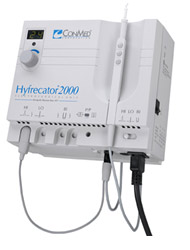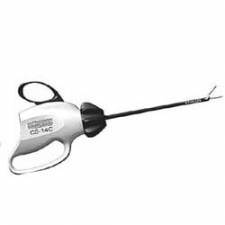A hyfrecator is a low power medical electro-surgical diathermy.
(Diathermy: from the Greek ~ Dia - through and thermy - heat.)
 To understand hyfrecation, the properties of electricity must be understood. The hyfrecator uses the capacitive effect of the high frequency electricity to force electrons to move from their own atom into the space of an adjoining atom, thus creating a flow of electrons over a period of time, measured in amperes. The resistance to the flow of atoms is called impedance, measured in Ohms, and force thar pushes the electrons through the impedance is called electromotive force measure in Volts.
To understand hyfrecation, the properties of electricity must be understood. The hyfrecator uses the capacitive effect of the high frequency electricity to force electrons to move from their own atom into the space of an adjoining atom, thus creating a flow of electrons over a period of time, measured in amperes. The resistance to the flow of atoms is called impedance, measured in Ohms, and force thar pushes the electrons through the impedance is called electromotive force measure in Volts.
The hyfrecator is used to rapidly and selectively destroy tissue by the passage of an electric current through the tip of the hyfrecator as it touches the skin. This will burn off the tissue in question. Small skin lesions can be treated without anaesthesia but the procedure may require topical or local anaesthesia.
It works by emitting low-power high-frequency AC (alternating current) electrical pulses via a probe, directly to the affected area of the body. The amount of output power needed is adjustable, and the device is equipped with different tips, electrodes and forceps depending on the electrosurgical requirement. (The electric current can interfere with an implanted cardiac pacemaker.)
The hyfrecator differs from other electrosurgical devices primarily in being low powered and not intended for cutting tissue, or for use in other than conscious patients. The reason is that the hyfrecator does not need to use a ground pad, and thus either passes a very low-powered current between forceps tips, or else between a single probe and the patient, with only the patient's self-capacitance providing a current sink (this is equivalent to considering displacement current to be the return current).
In this mode, the patient must sit or lie on an insulated table. Stray ground paths between the patient and foreign conductors (such as a metal table leading somewhere to earth-ground) can offer another capacitive reservoir, and burns may result between patient and the earth-ground from current flow between the patient and the earth-ground. For this reason, hyfrecation and all non-ground-pad electrosurgery is performed only on conscious patients who would be aware of the burn and discomfort from an unwanted earth-ground path. (In electrosurgery with a ground pad, this path serves as such a low resistance ground to the machine, that other paths become unimportant).
Because hyfrecation is a low-power modality, it can be used in some situations (such as very small nevus removal or skin tag removal) without local anaesthesia. In many other uses to destroy larger lesions, a local anaesthetic injection or regional nerve block is used. The pain from hyfrecation is due to the burning of tissue, and the pain of electrical current is absent, due to the high (radio) frequency which does not affect discharge of nerves. The Hyfrecator allows precise destruction of all types of cutaneous lesion (both superficial and deep) and controls surgical bleeding simply, quickly and effectively.
Bleeding can prolong even minor procedures and increase the risk of haematoma formation, infection and wound dehiscence that may lead to poor cosmetic results. The Hyfrecator is widely used for outpatient procedures that range from epilation to vasectomy. It is commonly used by Dermatologists in conjunction with curettage for the destruction of small well-defined skin cancers such as basal cell carcinoma and for the treatment of a wide variety of cutaneous lesions.
Targets of use
The hyfrecator has a large number of uses, such as removal of warts, pearly penile papules, desiccation of sebaceous gland disorders, electrocautery of bleeding, epilation, destruction of small cosmetically unwanted superficial veins, in certain types of plastic surgery and many other dermatological tasks. It is also instrumental in the destruction of skin cancers such as basal cell carcinoma.
Hyfrecators are used in two principal modes:
Desiccation
Desiccation, in which directly applied electrical energy kills tissue near the probe tip by heating it past the temperature at which cells can survive. The cells dry out and form a coagulum rather cellular vaporisation. In order to overcome the high impedance, the device uses high voltage and high frequency. This mode is usually employed with the probe in physical contact with the skin or lesion to be destroyed.

Fulguration
Fulguration happens when a deliberate spark is generated by nearly touching the sharp probe to the lesion or skin. This results in far higher temperatures at the point of contact of the spark to skin, causing very high temperatures and carbonization of the tissue immediately at the spark-contact point, and below it.
The distinction between fulguration and desiccation is largely artificial - for the purposes of treatment, but the physician should be aware that sparks are associated with more superficial tissue destruction and that good electrical contact is required for deeper tissue destruction. Furthermore, higher power settings are required for desiccation and coagulation and the effect on tissue is less immediately apparent than with fulguration.
Finally, the Hyfrecator may be used in conjunction with a dispersive patient return electrode plate. Under these circumstances the dispersive plate is connected to the dispersive plate connector on the Hyfrecator and the plate held in maximum contact with the patient's skin. The use of the plate increases the efficiency of the system, and until experience is gained the settings of the machine should be reduced. With the use of the return plate it is possible to produce deep monoterminal tissue coagulation.
The hyfrecator can be used in almost all fields of medicine, e.g. chiropody, dentistry, ophthalmology, gynaecology, and veterinary medicine.
Sources:
http://en.wikipedia.org/wiki/Hyfrecator
https://www.asit.org/assets/documents/Prinicpals_in_electrosurgery.pdf
https://www.conmed.com/en/products/patient-care/office-based-electrosurgery/electrosurgical-unit/the-hyfrecator-2000-electrosurgical-system
Compiled and Edited by John Sandham






